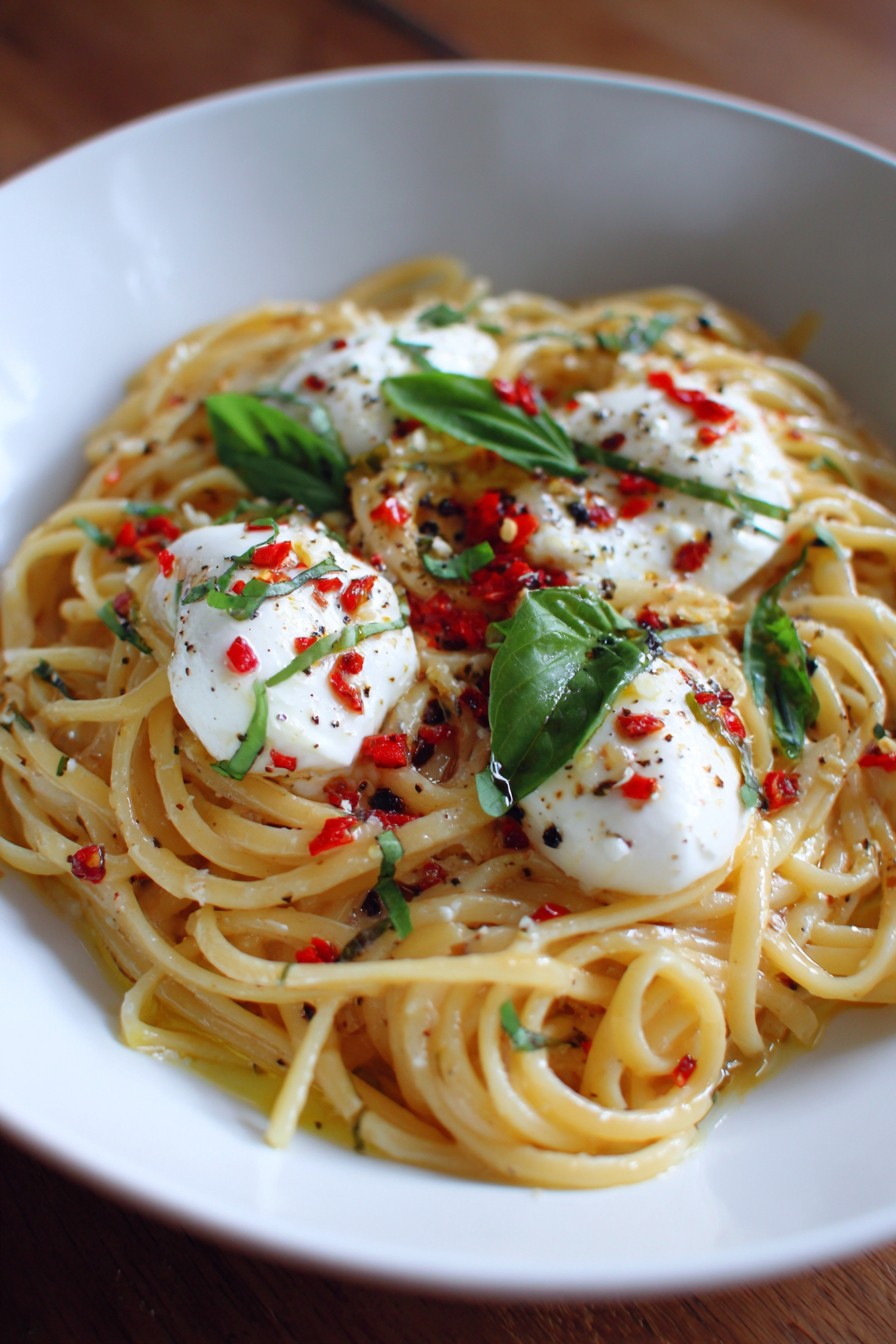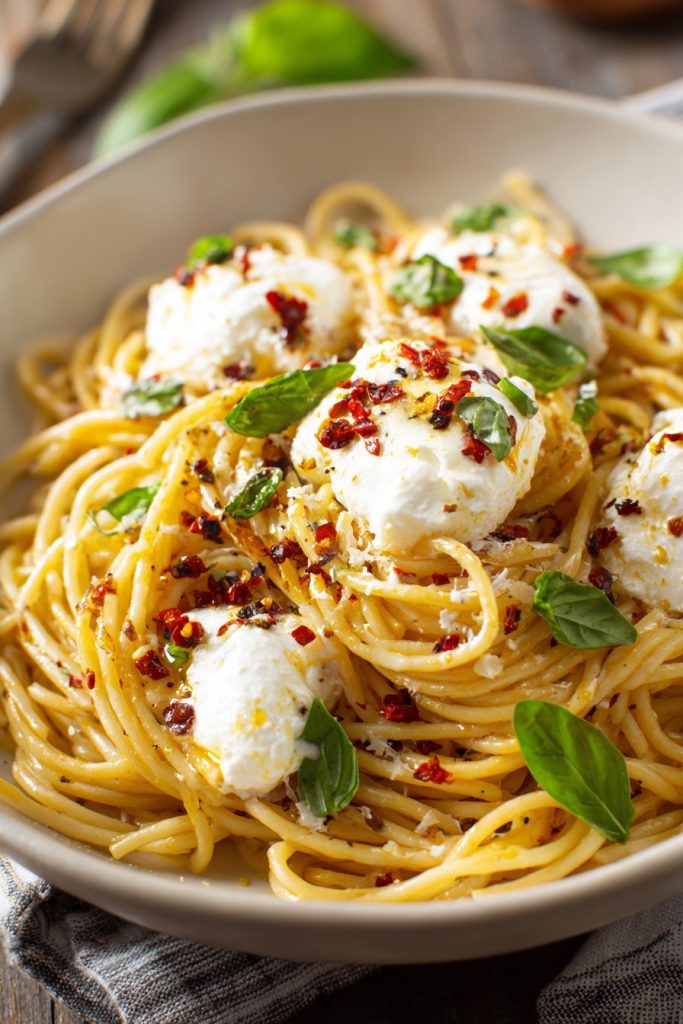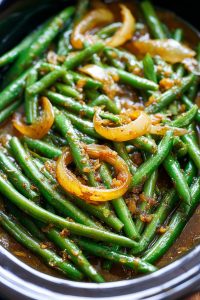Tired of the same old pasta routine that’s about as exciting as watching paint dry? This isn’t your nonna’s spaghetti—unless your nonna was a culinary rebel who believed cheese should arrive at the party like a diva making a grand entrance. Today we’re creating a dish where creamy burrata cheese melts into perfectly cooked pasta like butter on a hot summer sidewalk—only much more delicious and significantly less messy for your shoes.
Why This Recipe Works
- The burrata cheese acts like a creamy superhero, swooping in at the last moment to rescue your pasta from blandness with its oozy, dreamy center that’s basically cheese clouds from dairy heaven
- We’re using the pasta cooking water like liquid gold—that starchy, salty liquid becomes the magical glue that transforms oil and cheese into a sauce that clings to every noodle like your cat clings to the one piece of furniture you told it not to scratch
- The contrast between the hot pasta and cold burrata creates a temperature tango that’ll make your taste buds do the cha-cha—hot meets cold, creamy meets al dente, and your mouth becomes the dance floor of deliciousness
- Simple ingredients get to shine brighter than a reality TV star seeking attention, proving that sometimes the best things in life don’t require twenty-seven obscure ingredients from specialty stores that close at 3 PM on Tuesdays
Ingredients
- 1 pound dried pasta (linguine or spaghetti works beautifully)
- 2 balls of fresh burrata cheese (about 8 ounces total)
- 3 tablespoons extra virgin olive oil (the good stuff you hide from guests)
- 4 cloves garlic, thinly sliced (not minced—we’re fancy like that)
- 1/2 teaspoon red pepper flakes (or more if you like living dangerously)
- 1/2 cup reserved pasta cooking water
- 1/4 cup fresh basil leaves, torn by hand (no scissors allowed—this isn’t arts and crafts)
- Salt for pasta water (enough to make the Mediterranean Sea jealous)
- Freshly ground black pepper to taste (the pre-ground dust can stay in the cupboard)
Equipment Needed
- Large pot (big enough to give your pasta personal space)
- Colander (for the dramatic pasta waterfall moment)
- Large skillet or sauté pan (non-stick is your friend here)
- Tongs or pasta fork (wooden spoons need not apply)
- Measuring cups and spoons (eyeballing is for rebels and people who like inconsistent results)
- Cutting board and sharp knife (dull knives are just sad)
- Small bowl or liquid measuring cup (for that precious pasta water)
Instructions

Step 1: The Salty Sea Preparation
Fill your largest pot with about 6 quarts of water and place it over high heat like you mean business. When the water reaches a rolling boil that’s bubbling more enthusiastically than a toddler in a bubble bath, add a whopping 2 tablespoons of salt. This isn’t the time to be shy with the salt—we’re aiming for seawater levels of salinity here, because the pasta needs to absorb flavor from the inside out. Think of it as marinating your noodles before they even meet the sauce. Now add your pasta and give it a quick stir to prevent any sticky situations. Set your timer for 1 minute less than the package instructions suggest—we’re going for al dente, which is Italian for “has a backbone and won’t turn to mush when introduced to sauce.” While the pasta does its thing, place a colander in the sink and keep a 1/2 cup measuring cup handy for the most important part: rescuing that starchy pasta water before you drain everything.
Step 2: The Garlic Infusion Tango
While your pasta is busy becoming its best self in the boiling water, place your large skillet over medium heat and add the olive oil. Let it warm up for about 30 seconds until it shimmers like a mirage in the desert—you should be able to feel the warmth when you hover your hand above the pan. Add your thinly sliced garlic and red pepper flakes, and watch as they sizzle and dance in the oil. The garlic should turn lightly golden, about 2-3 minutes, but don’t let it go too far—burnt garlic tastes more bitter than your aunt’s comments about your life choices. We’re looking for fragrant and lightly toasted, not dark brown and angry. The red pepper flakes will bloom in the oil, releasing their subtle heat that’ll sneak up on you later like a plot twist in a mystery novel. Keep stirring occasionally because garlic has commitment issues and will burn if you look away for too long.
Step 3: The Pasta Water Rescue Mission
Step 4: The Sauce Emulsification Celebration
This is where the magic happens—keep tossing the pasta vigorously in the skillet, adding more pasta water as needed until you achieve a sauce that lightly coats the back of a spoon. The starch from the pasta water will emulsify with the oil, creating a creamy texture without any actual cream—it’s basically kitchen alchemy that would make medieval scientists jealous. You’ll notice the sauce going from watery to silky in about 2-3 minutes of constant tossing. If it looks too dry, add another splash of pasta water; if it’s too watery, let it cook for another minute while continuing to toss. The goal is what Italians call “mantecatura”—the glorious process of stirring starch and fat into creamy perfection. Your arm might get tired, but consider it your daily workout with delicious rewards.
Step 5: The Grand Burrata Finale
Turn off the heat and immediately transfer your perfectly sauced pasta to serving bowls or a large platter. Now for the star of the show: take your burrata balls and tear them open with your hands over the pasta—no knives allowed for this part, because we’re going for rustic charm and dramatic cheese rivers. Place the torn burrata pieces strategically around the pasta so every serving gets some of that creamy center. The residual heat from the pasta will gently warm the burrata without melting it completely, creating those beautiful pockets of cool, creamy cheese that contrast with the warm pasta. Scatter your torn basil leaves over everything like green confetti at a food party, grind some fresh black pepper over the top, and drizzle with a final thread of olive oil because we’re extra like that.
Tips and Tricks
Let’s talk about the burrata itself—this delicate cheese ball is basically mozzarella’s more sophisticated cousin who went to finishing school. When shopping, look for burrata that feels heavy for its size and has a firm outer shell with a slight bounce. Avoid any packages with excessive liquid or that feel too soft, as they might be past their prime. Store burrata in its liquid in the refrigerator, but take it out about 30 minutes before serving to take the chill off—cold burrata on hot pasta creates an unpleasant temperature shock that’s like jumping into a cold pool after sitting in a hot tub. When you’re ready to serve, don’t cut the burrata with a knife unless you want clean slices (which we don’t). Tearing it with your hands creates beautiful, irregular pieces that catch the sauce differently in every bite, plus it makes you feel like a culinary artist rather than someone who just followed directions.
Now about that pasta water—this isn’t just salty H2O we’re talking about. The starch that leaches out of the pasta during cooking is what gives the water its magical thickening properties. The water should be cloudy and slightly viscous, like a weak broth. If you forget to reserve it before draining, all is not lost—you can use regular hot water in a pinch, but you’ll need to add a teaspoon of cornstarch mixed with a tablespoon of water to mimic the thickening power. Better yet, just remember to save the water because we’re organized adults who plan ahead (mostly). The temperature of your pasta when it hits the skillet matters too—it should go directly from colander to pan without cooling down, because we need that heat to help create the emulsion with the oil and pasta water.
Garlic slicing is an art form here—we want thin slices that will crisp up slightly in the oil, not minced garlic that will burn in seconds. Use a very sharp knife and take your time, or use a mandoline if you have one and aren’t afraid of losing fingertips. The red pepper flakes should be fresh, not the ones that have been in your spice cabinet since the Bush administration (either one). If they don’t smell like anything when you open the jar, they’ve lost their potency and you should use more. Finally, when tossing the pasta with the sauce, use a confident motion that lifts the pasta up and lets it fall back into the pan—this incorporates air and helps the sauce cling better. Don’t be gentle here; be the pasta-tossing champion you were born to be.
Recipe Variations
- For a vegetarian protein boost, add a can of drained chickpeas to the garlic oil and let them crisp up for a few minutes before adding the pasta. The creamy chickpeas pair beautifully with the creamy burrata, creating a texture party in your mouth that’ll have you doing a happy dance around your kitchen. You could also toss in some roasted cherry tomatoes that have burst open and created their own saucy situation, or sautéed mushrooms that have absorbed all the garlicky goodness like little flavor sponges.
- If you’re feeling fancy (or just want to impress your dinner date), swap the red pepper flakes for nduja—a spreadable spicy Italian sausage that will melt into the oil and create a deeply flavorful, slightly spicy base that’ll make your taste buds write thank-you notes. You could also add lemon zest and juice to brighten everything up, or swap the basil for fresh mint or parsley depending on what’s taking over your herb garden this week. For extra crunch, top with toasted breadcrumbs or pine nuts that you’ve toasted in a separate pan until golden brown.
- Not feeling the long pasta shapes? This recipe works beautifully with short pasta like rigatoni or orecchiette that can catch the creamy burrata in their little pockets and crevices. You could also turn this into a pasta bake by transferring everything to an oven-safe dish, topping with breadcrumbs and extra cheese, and baking until bubbly and golden—though the burrata will lose its distinctive texture, it will still taste magnificent. For a heartier winter version, add cooked Italian sausage or pancetta to the garlic oil, or stir in some chopped kale or spinach during the last minute of pasta cooking for some green goodness.
Frequently Asked Questions
Can I use regular mozzarella instead of burrata?
While you technically can substitute fresh mozzarella for burrata, you’ll be missing out on the glorious creamy center that makes burrata so special. Think of mozzarella as the reliable sedan and burrata as the convertible sports car—both will get you where you need to go, but one is significantly more fun. Fresh mozzarella has a uniform texture throughout, while burrata has a solid mozzarella shell filled with stracciatella and cream that bursts open when you cut into it. If you must substitute, look for the freshest mozzarella possible and maybe add a drizzle of cream to mimic that luxurious texture, but honestly, just spring for the burrata—your taste buds will thank you.
How do I know when my pasta is perfectly al dente?
Al dente pasta should have a slight resistance when you bite into it, like a firm handshake rather than a dead fish. The best way to test is to fish out a piece about 1-2 minutes before the package’s suggested cooking time and taste it—it should be cooked through but still have some structural integrity. If it’s crunchy in the center, it needs more time; if it’s mushy throughout, you’ve gone too far. Remember that pasta continues to cook slightly even after draining, especially when you toss it with the hot sauce, so erring on the slightly underdone side is better than ending up with pasta pudding.
Can I make this recipe ahead of time?
This dish is best served immediately after preparation, as the burrata will continue to melt and the pasta will absorb the sauce, leaving you with a less creamy result. However, you can prep components ahead of time—slice your garlic, measure your ingredients, and have your burrata waiting at room temperature. The actual cooking process is quick enough that you can do it while your guests are sipping wine and pretending to be interested in your vacation photos. If you do have leftovers, they’ll still taste good the next day, but the texture will be different—consider it a culinary remix rather than a failure.
What if I don’t have enough pasta water saved?
If you forget to save pasta water or didn’t save enough, don’t panic—you can use hot tap water mixed with a teaspoon of cornstarch as a substitute, though it won’t be quite the same. The starch in pasta water acts as a natural emulsifier that helps the oil and water combine into a creamy sauce, while cornstarch will just thicken without the same flavor profile. Better yet, just remember that pasta water is liquid gold and treat it accordingly—maybe even give it its own special bowl and a little crown to remind yourself of its importance in your culinary kingdom.
Summary
This pasta with burrata combines simple ingredients with technique to create restaurant-quality results at home. The magic lies in properly cooked pasta, garlic-infused oil, starchy pasta water, and the dramatic burrata finale that makes every bite creamy perfection.



